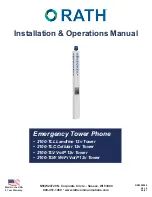
GAI-TRONICS
VoIP Telephone Configuration Guide
Page 59 of 78
In this example, a button (or input) assigned as memory 1 will first attempt to call speed dial 1.
If that fails, it will attempt speed dial 2; if that fails speed dial 3 and if that fails it will abandon
the call.
A button assigned as memory 2 will act similarly using speed dials 4, 5 and 6.
A button assigned as memory 3 will act similarly using speed dials 7, 8 and 9.
A button assigned as memory 4 will act similarly, but using five speed dials: 10, 11, 12, 13
and 14.
In this example, speed dials 15 - 20 are not assigned.
4.5.4 LED / Relay map string
This string controls the display function of 4 LEDs, 2 relays and 2 logic outputs, i.e. 8 outputs
in total.
Note that not all of these outputs are present on all models - refer to product specifications for
details.
The LED relay map string is a series of 8 codes, each code representing the function of a
single output, each code separated from the next by a space. The position of the code within
the string defines which input it is for.
IMPORTANT: Ensure there are no leading spaces at the start of the string.
The outputs are (In order):
Position 1:
LED 0 - not normally fitted
Positions 2 - 4: LEDs 1 - 3 (only normally available in Help Point products, usually only
LED1 is fitted)
Positions 5 - 6: Relays 1 & 2 (usually fitted to all products, except Auteldac 6 which only
includes Relay 1)
Position 7:
LED power select (normally set to OFF. Only enabled for products requiring
a higher LED drive voltage. Refer to GAI-Tronics for details)
Position 8:
Audio present (normally set to OFF. Only enabled for products requiring an
audio enable output. Refer to GAI-Tronics for details)
The function of each output is defined by 1 text character, separated from the next output by a
space.
The following lists all supported functions:
0 = Always Off
1 = Call Progress 1
2 = Call Progress 2
3 = Call Progress 3
4 = Call Progress 4
5 = Call Progress 5
6 = Call Progress 6
9 = Always ON
Where “Call Progress x” refers to the settings on the appropriate call progress information
page, in the IPBX Parameters section. See section 4.5.5 below.
Example: 0 1 0 0 2 3 0 0
LED1 is controlled by the settings on the call progress 1 information page, LEDs 0, 2 and 3
are off, relay 1 is controlled the settings on the call progress 2 information page, relay 2 is
controlled the settings on the call progress 3 information page, LED power select and audio
present outputs are off.
4.5.5 Call progress patterns and priorities
LEDs and relays can be configured to activate during various stages of telephone call
progress. For example, an LED could be set to indicate that a call is connected, or a relay
could be set to activate when an incoming call is ringing.
Additionally, a single output can be set to indicate different stages of call progress. For
example, the same LED could be set to flash when a call is ringing but illuminate steadily
when the call connects.
















































